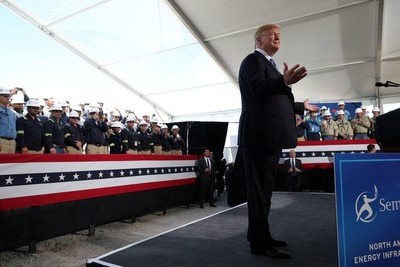US gas players refocus on Haynesville basin, buoyed by Trump LNG plans

Gas prices are rising as LNG producers in
Energy companies are planning and building big-ticket LNG projects that will require even more growth in domestic supply in the coming decade after Trump reversed a moratorium on new projects in the first days of his administration.
That is prompting energy producers to look again at gas plays that may help supply these future U.S. LNG plants.
Gas from
"I think everyone is really going to jump back into the
Momentum Minerals also told Reuters on Monday the mineral rights and royalties company is raising a fourth fund with partner Apollo Global Management to buy more rights in
Such moves by investment firms are often an early signal of future growth, and the rising expectations for
Murray Auchincloss, CEO of UK oil major BP, which holds more than half a million acres in the basin, proclaimed "the time has come for the
'A LITTLE GUN SHY'
Operators say they will move more carefully than in the past to avoid a bust. They also face challenges, starting with the time and cost of drilling the deeper wells the
"Producers are nervous about getting in front of demand again, because they did it last year, and it was painful," Huddleston said, referring to a warm winter in the U.S. in 2023 that drove down gas prices.
"Everyone's a little gun shy."
The breakeven price for new production in
In contrast, the breakeven in the Marcellus shale field, which covers
Gas futures will need to stabilize around
Analysts predict prices will be lower than
"Our hopes are that operators have learned their lesson and won't get ahead of their skis," he said.
(Reporting by
(c) Reuters 2025. All rights reserved. Republication or redistribution of Reuters content, including by caching, framing or similar means, is expressly prohibited without the prior written consent of Reuters. Reuters and the Reuters sphere logo are registered trademarks and trademarks of the Reuters group of companies around the world.
Related News
-
MT Newswires - 17 minutes ago
-
MT Newswires - 18 minutes ago
-
MT Newswires - 19 minutes ago
-
Factbox-Trump's tariffs and threatened trade actions
Reuters - 32 minutes ago
-
Shell Unusual Options Activity
Benzinga - 46 minutes ago
-
Update: Market Chatter: DuPont Mulls Sale of Kevlar, Nomex Brands
MT Newswires - 48 minutes ago
-
Market Chatter: OpenAI Must Convert to For-Profit Entity or Funding Could be Slashed by $10 Billion
MT Newswires - 49 minutes ago






